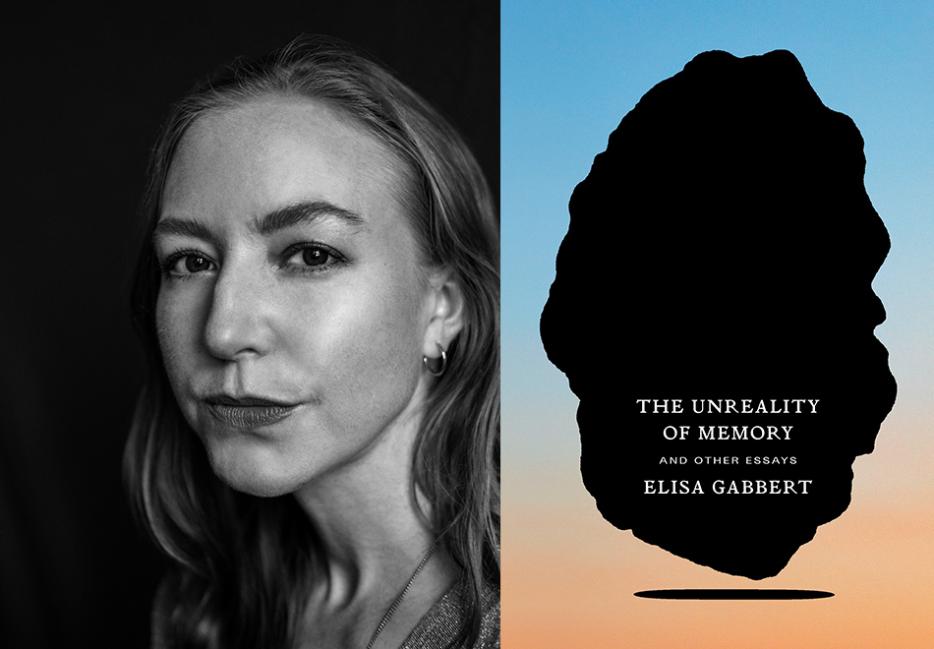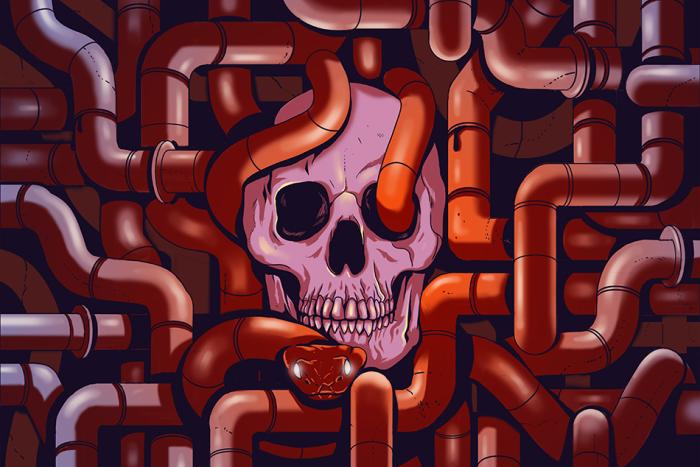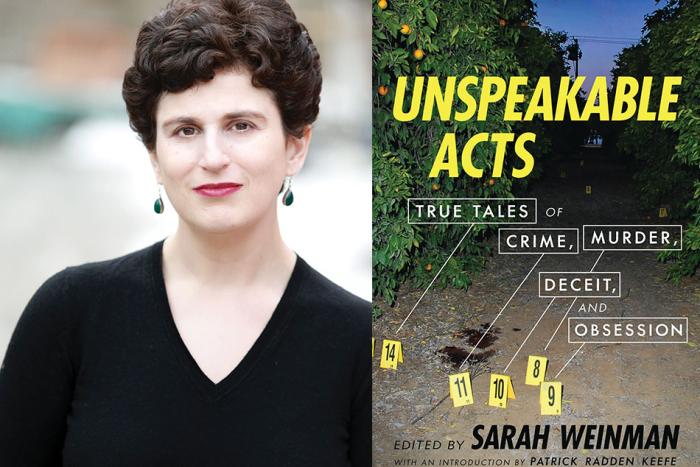When the pandemic first hit, I checked every hour or so monitoring the increase of cases in the United States. “Ten cases in Colorado,” I’d tell my husband. “And a new one in New Mexico.” Then our family got sick at the beginning of February, and in my Theraflu-induced haze I scrolled through dozens of news pages reporting on COVID symptoms, my heart beating faster as I read each list. I do this: obsess, especially over disaster, or storms, or any element of life I can’t control, as though infusing as much information about it as I can into my brain will somehow allay the fear.
The Unreality of Memory by Elisa Gabbert (FSG) felt like this: perfectly synthesized research about facets of human fear in twelve essays. When Gabbert mentioned something about megastructures, or herbs like asafoetida, I went into an internet rabbit hole, scrolling through dozens and dozens of Reddit posts of objects of unimaginable size, or reviewing studies on Pubmed of herbs reportedly used to “cure” hysteria. Most of all, The Unreality of Memory caused me to question myself and my place in the world. Not in an existential way; Gabbert’s essays provided context for the role of humanity in a world of chaotic disaster. Those events which are uncontrollable, unavoidable. In “Doomsday Pattern,” Gabbert relays stories from Chernobyl Prayer by Svetlana Alexievich, a collection of testimonies from survivors. One particular story gripped me, in which Alexievich spoke of meeting an old man in a dead village. “Aren’t you afraid?” she asked. He answered: “Of what? You can’t be afraid the whole time, a person can’t do that; some time goes by, and ordinary life starts up again.”
I take this thought with me when I put my mask on to buy groceries, or when I see people eating out at restaurants, walking through malls with their masks slung beneath their chins, sucking on sodas from the food court. When pandemic restrictions were first put in place, the grocery stores were either deserted or had people lined up around the building, waiting to get in. The aisles were half-empty; no toilet paper, bags of flour. Even cheese. And if you went at night, just before closing, it felt a bit like a ghost town, complete with an eerie cast to the empty parking lot and a slight sense of guilt for getting tortillas for dinner or a last-minute snack.
The Unreality of Memory breaks apart the most looming threat to human existence—disaster—and examines it through facets: how our news reports it and how we digest that news; how we view ourselves and how that, itself, may be unreliable; our unstable sense of happiness; our historical understanding of disaster; how our society has treated those we deem “dangerous” or “untrustworthy,” which is its own kind of disaster. How does a person handle what can’t be controlled? Mask orders are still in place where I live, and were just extended for thirty days. But it seems as though many people have resumed with ordinary life. The parking lots are full; no one is waiting in lines anymore. A few people slip into Walmart mask-free. The old man in the dead village might be right: a person can’t be afraid all the time, even if they need to be. Ordinary life pulses on.
Over email, I talked to Gabbert about the nature of self, the desire for normalcy, and whether or not a stable reality truly exists.
Elle Nash: So much of your work right now feels extremely timely (and I bet you're tired of thinking about that). Perhaps that is what it is like carrying around thoughts of disaster—on a long enough timeline, a disaster will be inevitable, confirming all our fears. While I was reading your essay on pandemics, I wondered, is it surreal for you, having written “The Great Mortality” in 2018, even quoting Dr. Anthony Fauci, to now live through this?
Elisa Gabbert: That’s the thing, so many disasters are inevitable that if you just keep predicting them, at some point you’re going to be right (and in an infinite multiverse, every disaster is inevitable and doomed to repeat infinitely!). One of my reviews was given the headline, “She predicted a pandemic”—of course, I didn’t predict anything, I just read some books by people who study this stuff. What did seem clear to me was that the election of Donald Trump was going to make us uniquely vulnerable to disaster as a country, even more so than we already were. But the fact that the book was released during a pandemic was just dumb luck (dumb bad luck, to be clear), and I don’t think I was really any more psychologically prepared for this than anyone.
You quote Barbara Tuchman: “What was the human condition after the plague? Exhausted by deaths and sorrows and the morbid excesses of fear and hate, it ought to have shown some profound effects, but no radical change was immediately visible. The persistence of the normal is strong.” You're in the process of promoting your book right now; anyone who has had a book come out in the last six months has really had to switch it up. Do you think there is a strong desire at things like virtual literary events to continue what is normal, even though it very much isn't normal?
I think there’s a strong desire to act normal everywhere. People get very self-righteous about it, but apart from the flashes of terrified awareness, or the truly unbearable days or weeks, really, what is the alternative? Should we all just run around screaming all the time? Part of me wants to do that! Part of me absolutely wants to check myself into an institution for an old-fashioned rest cure. But most of us have responsibilities to other people. I mean even if you don’t have kids or a family, you kind of have responsibility if you live in a society. If you don’t normalize this hell life a little, you just spiral into useless despair, and you can drag everyone around you down with you—despair is a second contagion. But you asked about book promotion. So I guess I’ll say that one of the few remaining things I’m truly grateful for is literature—when so much of life has been stripped away, books are still a reliable source of something like happiness, the life of the mind. So I don’t feel particularly guilty or conflicted about promoting my book, within reason. (This is my life! My one wild and precious life!!)
The essay in your book which struck me the most was about vanity. I couldn’t stop thinking about it—how obsessed we are with our reflections, the implications of preferring it over something unfiltered and undoctored—and by that I also mean unreflected. For years I’d thought of my mirror self as the more accurate version, rather than the photo being true, and now I just feel a little fucked up about it all. Yet, it somehow feels important for me to obsess over this; like contemplation on the nature of selfhood. I wonder what you make of the term “navel-gazing” in relation to self-contemplation—is it valid to criticize this kind of contemplation as “excessive,” or is it a way to dismiss those of us who do get something out of it?
A few people have told me that this was their favorite essay, and I wonder if it’s not that it’s also rather uncannily timely—we are all seeing ourselves on video much more than usual lately, and that much self-seeing seems to trigger an unexpected crisis of the self, an othering of the self (that can’t be me!). Anyway—I think selfishness and self-contemplation are very different. Philosophers and monks and saints have been doing the latter since before there were mirrors. The term “navel-gazing” strikes me as deeply anti-intellectual. Consciousness is one of the great mysteries! It’s more interesting than lint, and I don’t even find lint uninteresting (why is it always the same blue-gray color?).
Why do you think the self (as a concept) is drawn so much to… well, thinking about itself?
Because it’s inescapable, I guess. When you’re lying alone and awake in the dark, your self is still there.
More terrifying were your descriptions of illnesses in which patients could no longer recognize their own reflection. It's harrowing to think of—that this loss of recognition can occur. This isn't a question, just a realization that selfhood seems rather fragile when faced with the countless actors against brain health, or even overall health and safety. The essay felt like a fulcrum of the whole book: the fragility of self seems hinged on whether we can keep our environment inhabitable, keep ourselves safe from disaster, or viruses, or threats, which as a collective species, is unfathomable. When you were assembling the manuscript, how did you decide the order you would present each piece?
I’ve always found sections very helpful when ordering a manuscript, because it reduces the number of possible combinations, or at least makes it feel like there are fewer combinations. Once I’d organized the essays into three sections, the order of the sections felt obvious, so it was just a matter of determining the order within each section. One thing I definitely didn’t want to do was front-load the best stuff, because I hate when you’re reading a collection and it starts to lose your interest instead of building momentum. I decided to start with the crowd-pleaser stuff, the big explosions, etc.—when I was shopping the book proposal, a couple of editors told me they wished the whole book was just a longer version of the first section. But the middle section is my favorite. Also, sometimes I hint at something in one essay that is later explored at more length in another, and that helped me order the collection as well—the question of whether I wanted those parts to serve as call or echo.
The echoes made the work feel cohesive, inter-relating all of these elements (I felt like "Witches and Whiplash" and "Sleep No More" were so intertwined). In "Witches and Whiplash" you yoke concepts of classical hysteria, conversion disorder, #metoo, and the tangential experience of pain together, along with an analysis of crowd catharsis and the contagious possibility of suicide and violence; you also state you took fifty pages of notes for this particular essay alone, and that it led to a kind of frustration in the many threads you wanted to follow. Can you tell me about your process in forming and completing this essay?
Those were the last two pieces I wrote (not counting the epilogue, which I decided to add later, at the suggestion of my editor); my deadline to turn in the manuscript was approaching and I was kind of unraveling. Originally, these two essays were supposed to be three. My book proposal had them as “A philosophical/personal essay on pain, both psychic and physical”; “An essay on sleep and awareness and states in between”; and, “An essay on ‘mania’: fandom, panics, hysteria, delusions, and witch hunts.” My entry into the sleep essay (I’m a sometimes insomniac) was an experience I had with anesthesia, so it just made sense to combine the consciousness essay with the pain essay—they were so intimately related. I ended up deciding that piece is really about suffering, and the meaning of happiness. But formally it’s pretty similar to the other essays in the collection.
“Witches and Whiplash” is an outlier—it’s the longest piece in the book and the only one that’s divided into titled sections. I actually stole that structure from Crowds and Power by Elias Canetti, an amazing book that I used as a source for the essay. As you mention, there’s that meta moment at the end where I confess that I over-researched the essay; there was just so much material and it all felt so painfully relevant to what we were, and are, living through. It could have been a whole book! I took so many notes that I couldn’t see my way into writing the piece in my typical structure—if I’m writing a four- or five-thousand-word essay, I usually break it into three or four sections or “movements.” I needed some more granular organizing principle. Crowds and Power is organized into lots of short, titled sections, shorter than chapters, with names like “The Discharge,” “The Eruption,” and, “Slowness, or the Remoteness of the Goal.” So that’s how I ended up structuring the essay, and it gave me a way to talk about all these different but similar concepts, which are basically all exterior physical and social manifestations of confusing and traumatic interior states. That’s the connection between witch hunts and whiplash.
In “True Crime” you explore the evolution of news and the nature in which journalists’ biases—conscious or not—lead them to pursue work that fits the current narrative. It’s self-fulfilling: the 24-hour news cycle exists, so news companies feel pressure to fill the space, yet they created the cycle in the first place. And like that, people who read the news begin to expect it. “This is how it becomes parasitic: We need the drugs, and they need us to buy them,” you state. You also bring up the responsibility of the news consumer, equally important, in our current climate. OpenAI is creating algorithms that mimic the sound and texture of human-written text; I see friends online routinely engage with Twitterbots without realizing they are, in fact, not real; I’ve run across AI-created articles in major magazines, some egregiously bad, but others almost undetectable; and deepfakes, that beautiful buzzword, become more and more convincing with terrifying awe. All of this essentially constructs chambers around our individual paradigms, making it more difficult to parse, for the uneducated news consumer, what is real and what isn’t. But like the drug it is, people want to believe their selected narratives—and they’ll find and seek the information out there to confirm it. Do you think we’re moving into a post-truth world? What does that world look like, to you?
I think the internet, social media, and technology in general accelerate and make more terrifying what was probably always already true, that “reality,” as we perceive it in the present and preserve it in memory, is highly unstable. The equipment we use to process the world is fallible at every level—the news media is fallible because our minds are fallible. The errors keep compounding. History books are fallible too, of course—when I was a kid there were still high school textbooks in the south that called the Civil War “the War of Northern Aggression.” This isn’t to say there aren’t any truths, that there aren’t any facts—slavery was real, the Holocaust was real. The migrant camps are real. But we seem incapable of propagating these facts across time and space in such a way as to produce agreement, on the one hand, that genocide and white supremacy are wrong, are evil, and on the other hand, that these things are even happening. And so, they continue to happen. Holocaust denial predates the internet, but I do think it makes denial easier, by providing unmediated sources that people can convince themselves are reliable. (I don’t know the solution.)
What got you interested in writing about doom and disaster in the first place?
Broadly, it was some combination of the direst election year of my lifetime so far (this one has proven to be direr) and the pervasive sense of—not even climate anxiety, really, but climate grief?—among people my age and younger, especially. When Trump was elected I felt some sense of urgency to write about apocalyptic feelings. But as you intimated in your first question, I’m pretty sick of it all now, of peering over the precipice. I’m glad there are people who still want to read about earthquakes and plagues though. Somebody has to!
When I look at the cover... I think I see a floating iceberg. With a hole beneath, or perhaps its shadow. Because of the title and its relation to the ethereal and personal experience of one’s mind, it’s like a Rorschach test. I ask myself: Is the blue the sky, and the red the sunset? Is it surrealist, like a floating boulder? What is the story behind this image—were you involved in the process of developing it, did you get to choose or throw out concepts early on when creating it?
When I filled out my cover questionnaire, a brief survey about what I did or didn’t want the book to look like (I remember one of the questions was “What is your least favorite color”!), I sent along one image for inspiration: a paperback edition of Camus’ The Myth of Sisyphus, which has Magritte’s The Glass Key on the cover, a boulder floating among mountains. I love the look of mid-century philosophy texts, and they influenced my title choice too (all those X-of-Y-type titles—The Poetics of Space, The Jargon of Authenticity). The designer, Thomas Colligan, did something I loved on the first try. It recalls the Magritte almost subliminally, and is even more ambiguous: Is it a presence or a void? A hyperobject, a black hole, a blind spot, an asteroid? I find it to be wonderfully ominous.






